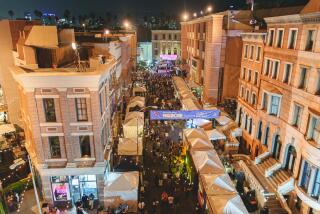What’s Cooking at the Getty? A History of Fabulous Banquets
- Share via
From the Middle Ages through the 18th century, a banquet was just not a party unless it came with a pageant and festive scenery. And often that scenery was edible, as you’ll be able to see in “The Edible Monument: The Art of Food for Festivals,” which opens at the Getty Center on Saturday.
The edible part was often cakes, hams and cheeses stuck onto some grandiose stage set representing a temple or mountain, and the guests, or sometimes the common people, could grab whatever they wanted. Getty rare-books curator Marcia Reed has assembled a number of 16th through 18th century prints that show positively stupefying food monuments, some of them 60 feet high. One included climbing poles with a halo of hams and roast birds at the top for the best climber.
There was also a tradition of creating allegorical centerpieces for the banquet table. When a medieval chef wanted to create something of the sort, it might be a pie, which could be made to look like a castle, for instance. But the Greeks who fled to Italy after the fall of Constantinople in 1453 didn’t just revive classical learning in Western Europe--they brought the knowledge of making molded figures from sugar, which was capable of much greater things than pie dough.
*
However, cast sugar wasn’t perfect. “The effect is rather granular,” says Ivan Day, whose re-created 18th century French table centerpiece is the, well, centerpiece of the Getty exhibition. In the later 15th century, the Italians hit on the idea of mixing sugar with a vegetable product called gum tragacanth, which had been used for binding medicinal powders into pills (pastilles). This gum-sugar mixture, which is still used (and technically edible, though not quite delicious), is called pastillage.
“Pastillage is very spreadable and plastic,” says Day. “It’s a much finer molding material than porcelain--in fact, when porcelain plates with molded decorations appeared in the 18th century, they copied pastillage forms.”
His centerpiece, from a designin the 1749 book “La Science du Mai^tre d’Hotel Confiseur,” shows the witch Circe turning Ulysses’ companions to pigs; it’s an allegory about the danger of gluttony, presumably something to keep in mind at a banquet. Like most mid-18th century centerpieces, it features containers of colored sugar crystals designed to look like the flower beds of a formal garden. Accompanying the centerpiece is an exhibition on how it was made.
Day, who is a botanist by profession, brought his pastillage temple all the way from England--on the seat next to him on the plane. In the end he had to re-create a number of the smaller sugar figures in the scene because they broke in transit.
“These things are volatile and fragile,” Reed says. “They’re ephemeral, in a way like fireworks.”
*
* “The Edible Monument: The Art of Food for Festivals,” Saturday through May 21. Getty Center, 1200 Getty Center Drive, Brentwood, (310) 440-7300. Open Tuesdays and Wednesdays, 11 a.m.-7 p.m.; Thursdays and Fridays, 11 a.m.-9 p.m.; and Saturdays and Sundays, 10 a.m. to 6 p.m. Free. Parking $5.
More to Read
Eat your way across L.A.
Get our weekly Tasting Notes newsletter for reviews, news and more.
You may occasionally receive promotional content from the Los Angeles Times.









